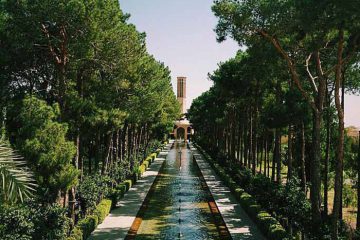Iranian Food; An Unbeatable Deliciousness
Iranian food: To understand a nation’s culture eat their food, they say. This belief is absolutely true about Iranian food culture which is not separate from the culture itself. Through the Persian cuisine history, ancient Persian food and Iranian food recipes have combined and altered to their fullest. It has been frequently asked that is Persian food healthy? Further in the text we will guide you through iranian food street, how to eat Persian food to stay healthy; not that it might cause you harm; no. You just have to know when to stop eating! In Iranian food culture Iranian drinks are an inseparable part of the meals.
The delicious Iranian food that you are about to see were carefully selected by Gisoo Misha Ahmadi as Iran’s top ten favorite dishes:
Now let’s have a quick look on Iranian top wanted meal list:
Kebab
Or (Lamb, Chicken, Lamb Liver, Ground Meat)
There are more variety of Kebabs than you can think of. First, we can talk about koobideh, ground meat seasoned with minced onion, salt and pepper. It might sound simple, but the taste is sublime. Then, there is kebab-e barg, thinly sliced lamb or beef, flavoured with lemon juice and onion and basted with saffron and butter.
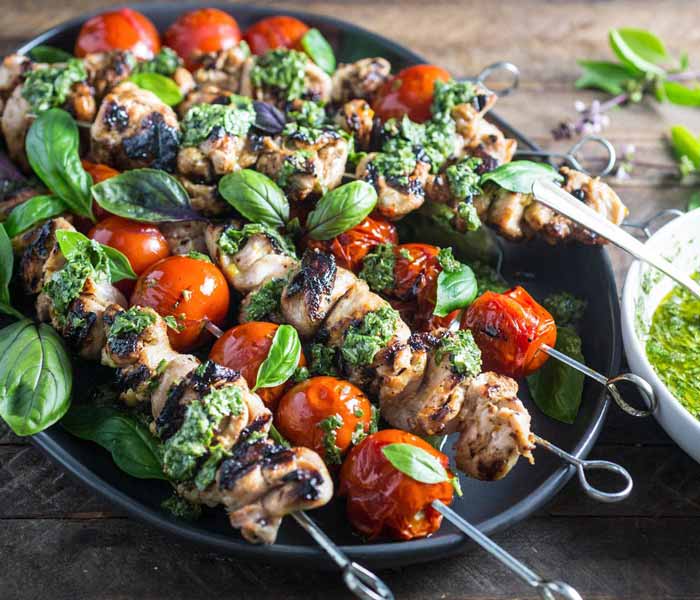
Chicken kebab also known as joojeh, is traditionally made from a whole chicken, bones and all, to add to its flavour, marinated in lemon and onion, and basted with saffron and butter. If you’re up for it, you can find jigar, lamb liver kebab, garnished with fresh basil leaves and a wedge of lemon.
Ash Reshteh
or (Noodle and Bean Soup)
A soup full of noodles which is richly textured with beans, herbs and leafy greens like spinach and beet leaves. It’s topped with mint oil, crunchy fried onions and sour kashk (a fermented whey product that tastes akin to sour yogurt).
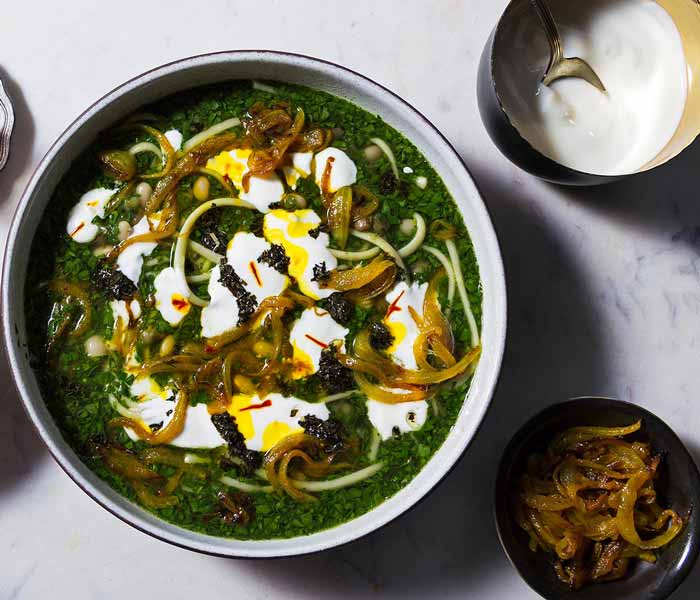
Ash Reshteh is also eaten as a main meal. It is extremely popular in winter and high up the mountains on a cold winter day.
The noodles are thought to represent the many paths of life, and this soup is traditionally served when someone sets off on a long journey. Because of its auspicious ingredients, it’s also part of the menu for Norooz (the Persian New Year).
Baghali Polo With Mahicheh
or (Rice With Dill And Fava Beans and Lamb)
Rice in Iranian cooking can be prepared simply with butter and saffron, known as chelo. However, just as often, it’s cooked with other ingredients and called polo. Polo can be prepared with herbs, vegetables, beans, nuts, dried fruit, meat and even noodles, and acts as the centrepiece of the meal.
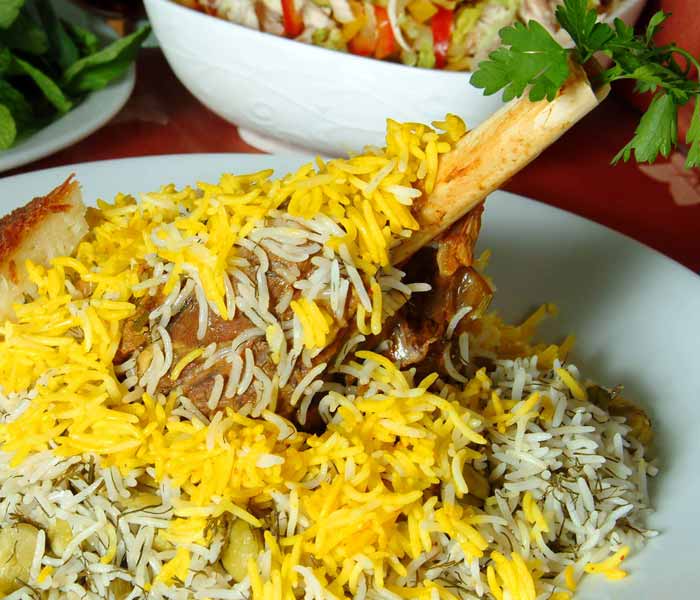
The Baghali Polo with Mahicheh filled with green dill and favas is often cooked with very tender chunks of lamb. Alternately, it may be served alongside lamb on the bone. It would be better if rice has a mild saffron flavor, with the saffron mixed into the rice just before serving Baghali Polo.
Fesenjan
or (Pomegranate Walnut Stew)
As an iconic stew, Fesenjan is an essential part of every Persian wedding menu. It includes tart pomegranate with chicken or duck. To make a thick sauce, ground walnuts, pomegranate paste and onions are slowly simmered. The process sometimes takes up to two hours.
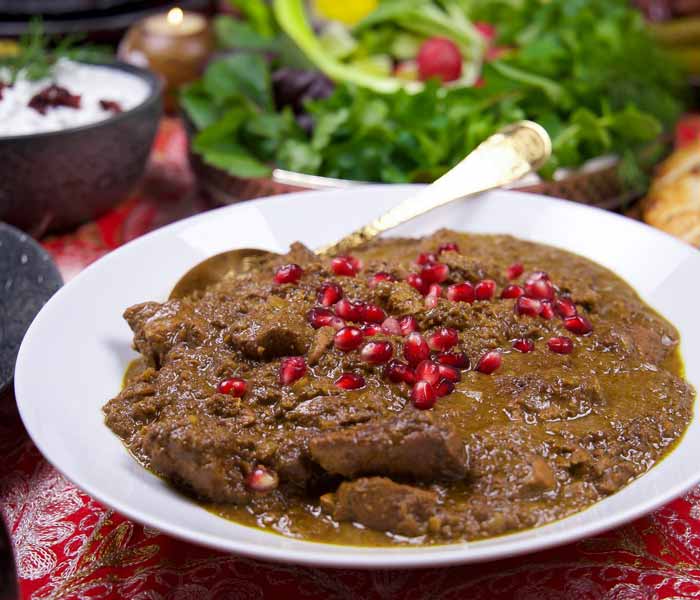
To be more delicious, sometimes saffron and cinnamon are added, and maybe a pinch of sugar to balance the acid. Fesenjan has a long pedigree.
At the ruins of Persepolis (the ancient ritual capital of the Persian Empire), archaeologists discovered inscribed stone tablets from as far back as 515 B.C., which listed pantry staples of the early Iranians. The walnuts, poultry and pomegranate preserves are exclusively mentioned; the key ingredients in Fesenjan.
Ghormeh Sabzi
or (Green Herb Stew)
The most loved Iranian stew, Ghormeh Sabzi is made from herbs, kidney beans and lamb satisfies two Persian flavour obsessions: it’s sour and full of herbs. The stew is seasoned with dried limes (limoo omani in Persian).
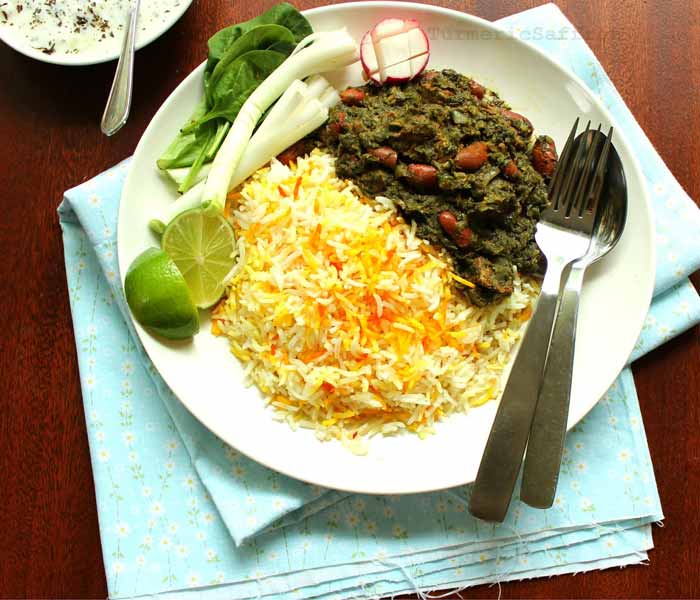
These limes are preferably extra intense and sour, with a bittersweet taste that gives the stew a unique flavour. The other constant in Ghormeh Sabzi stew is fenugreek leaves, a rare unique taste; unfamiliar to most westerners. Moreover, other herbs are included such as parsley, coriander and scallions.
Tahdig
Or (Crunchy Fried Rice)
If you eat Persian food and don’t have a bite of Tahdig, it would be like you have missed the soul of the meal. Tahdig is the crisp, golden fried layer of rice at the bottom of the rice pot, and it tastes like a mixture of popcorn and potato chips, but with the delicate flavour of basmati ice. Tahdig is usually not printed on the menu exclusively, so you better have to ask for it.
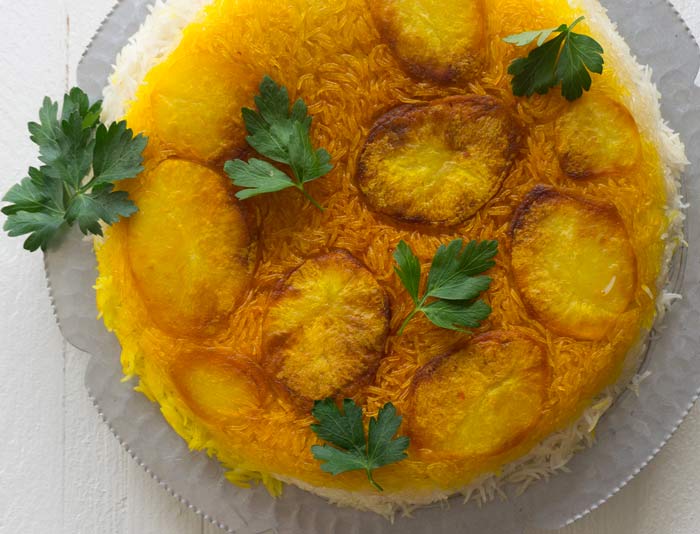
At Iranian family gatherings, there are always plenty of leftovers, but not even a single tiny piece of Tahdig; it just disappears in blink of an eye. Mostly, it’s eaten as a side dish, and it’s forgivable to pick it up and eat it with your fingers. There are tons of different types of Tahdig with potato and various types of bread.
Only a true Persian cook can deliver the crispy golden Tahdig; if you are an amateur you might burn it and end all the fun!
Zereshk Polo
Or (Barberry Rice)
Sour flavours are popular among Iranians. Sourer than cranberries, barberries have a vibrant red colour. Zereshk Polo is studded with the red berries, which are dried and then rehydrated before cooking. The rice is cooked with plenty of butter to soften the intensity of the berries.
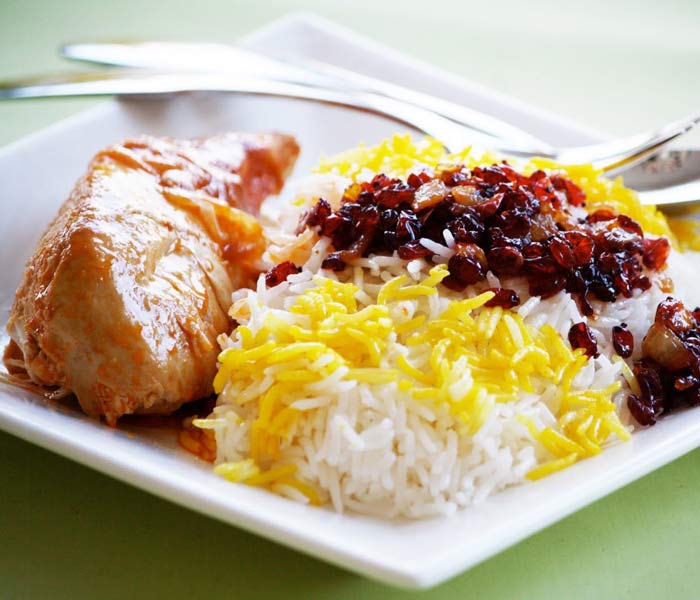
To make the food more tart, quince, rhubarb, green plums, sour oranges, lemons, limes, dried limes, sour cherries, tamarind, sumac and pomegranate are all used in Persian cooking.
Zereshk Polo is often eaten with different stews; such as with chicken stew, Fesenjan stew, and fish stew.
Ancient Persian Food
Native and ancient Persian food’s scope is so wide due to the geographical position of the country. To find the evidence of ancient Persian food you can refer to the walls of Persepolis where the depiction of lavish Nowruz feast is displayed.
Ancient Persian food had been influenced by the multiple invasions to the country which later in the post we will discuss it further. Some ingredients have always been in the recipes of ancient Persian foods such as pistachios, almonds, walnuts, saffron, mint, oranges, pomegranates and grapes.
Iranian Food Culture
Iranian food culture is greatly varied due to the range of culinary traditions across the Iranian provinces. If you want to experience the true Iranian food culture you’d better give it a try at an Iranian house; because most restaurants have to limit the food type and there is therefore, very little variety.
As a general description, Iranian food culture tends to be colourful, healthy and simple. Variable tastes are achieved via herbs, light spices and fruit and the resulting dishes are mild as opposed to spicy.

Iranian food culture is accompanied with hospitality. As a matter of fact, you likely won’t be able to finish the whole meal since there is always much to eat; you will feel you ate a whole cow!
Tea is an essential part of the Iranian food culture and hospitality. You are expectably to be offered tea in a glass (always black). Second to the drinks, it is much possible to be offered a wide variety of seasonal fruit.
As a staple building block of any Iranian food culture, Berenj (=rice or polo) is cooked in the most beautiful mouth-watering variations. Frankly speaking, rice preparation is a food art in Iranian food culture.
Related post: List of Top Iranian Handmade Souvenirs
Persian Cuisine History
Persian cuisine history has experienced lots of ups and downs. Iran, once the centre of the Persian Empire, neighbours the former Soviet Union countries, as well as Afghanistan, Pakistan, the Arab states and Turkey.
Although Iran is part of the Middle East, it has been influenced by Europe, the Far East and Africa, surely by its location on the Silk Road trade route.
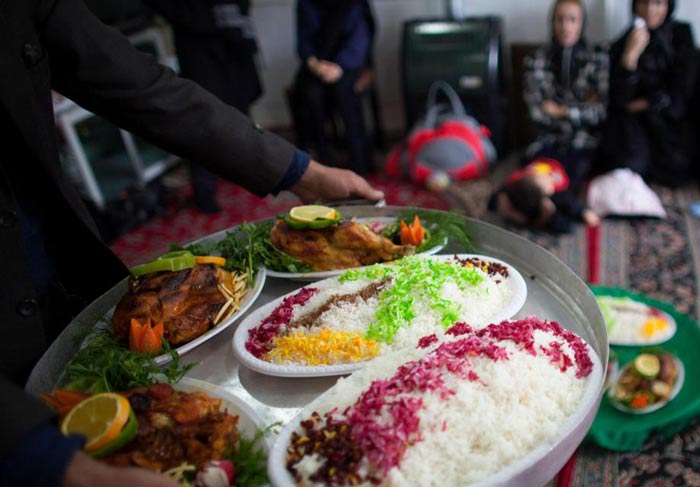
Numerous wars and invasion in Iran have led to the extremely variety of food. During 4th century, Alexander the Great, conquered the Persian Empire, and later it was invaded by Arabs, Turks, Mongols and Uzbeks; all these invasions had important roles in Persian cuisine history.
While Iranians already had a well-developed food identity before these invasions, they absorbed and embraced what the outsiders brought in. Think Russian-style borscht with cumin and cilantro as an example or Chinese noodles in a soup of beans, herbs and sour fermented whey (what we call Ash Reshteh).
How To Eat Persian Food
The question of how to eat Persian food can be answered easily.
Here are some tips on how to eat Persian food:
#1 Have a list of the food you want to try with their names in Persian. In this case, you won’t get confused with all the weird names on the menu.
#2 Kebabs are really tempting, however, make sure to keep an eye for anything strange on the menu and order that one instead. You can almost find Kebabs wherever you go but that certain dish might not be found ever again!
#3 Be aware not to order too much! Persian food usually comes in big portions. Sometimes one portion is large enough to feed two people, especially if it comes with rice.
#4 it would be better to do your research! Don’t just rush into any restaurant. Not always the good looking restaurants serve the best food. Surprisingly, the humble looking restaurants (not necessarily always though) are the more traditional ones and more popular by locals which means the food is more acceptable.
Iranian Food Recipes
In almost every Iranian food recipe you can find berenj (rice or polo). Not only a simple boiled rice but also a vast variety of cooked rice which earlier in this post we mentioned some of them.
Variable tastes are achieved via herbs, light spices and fruit and the resulting dishes are mild as opposed to spicy. For a single food across the country there might be multiple Iranian food recipe available. Each region might cook that meal with the ingredients discoverable in that religion only.
So, for an example, Fesenjan is cooked sour in the central parts of Iran such as Tehran contrary to the sweet Fesenjan of eastern provinces such as Mashhad.
Iranian Drinks
Iranian drinks can be dived into warm and cold categories:
Warm Iranian drinks:
Traditionally the first thing that is offered to a guest is tea; black tea. No matter the time of the day whether it is time for breakfast or even after lunch, tea is always welcomed. Usually tea as an Iranian drink is served with sugar cubes.

Herbal tea are also popular due to the healing properties they have.
Click to read: Looking for an Iranian Tour Agancy?
Cold Iranian drinks:
Cold Iranian drinks are traditionally served in warmer seasons. Flower essences are really popular and they are called “Aragh” which sometimes includes seeds like chia seed. Each flower and herb has its own aragh and therefore its own medical properties as well.
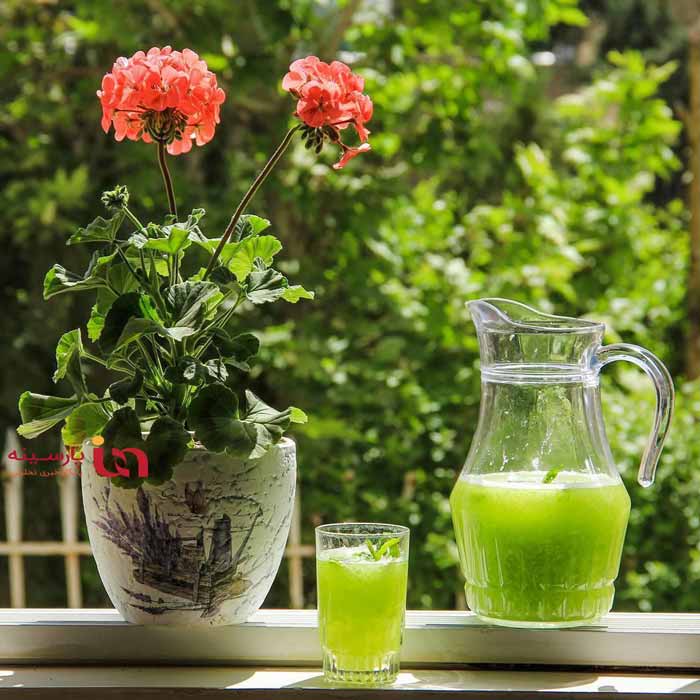
Araghs are a major part of traditional Iranian drinks and medicine.
Iranian food street
Iranian food street:
Is Persian Food Healthy?
Common to all the Iranian provinces is the fact that Persian food tends to be both healthy and nutritious.
If you want to eat in a restaurant, you are likely to be happy with the standards of cleanliness and hygiene nevertheless if you are a guest in an Iranian house you have nothing to worry about.
As with any country however, it is advisable to only eat hot food from street stalls and it is better if you observe how the food has been cooked e.g. ensuring sufficient standards of cleanliness.
The only way you can get sick by Persian food is the fact that you can never stop eating; even if you feel full you will still be craving for more!

